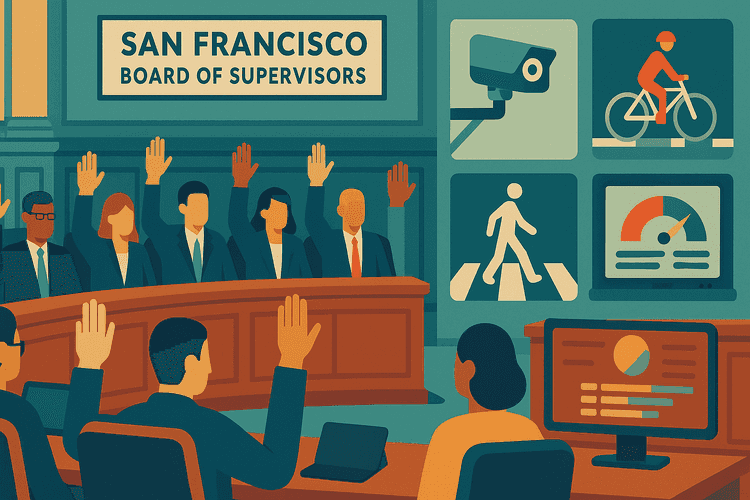$10M Bid-Rigging Probe - Official Suspended
PLUS: Welfare Eligibility Tightened to Curb “Drug Tourism”
What You Need To Know
Here’s what happened around the city for the week of September 21, 2025:
- $10M Bid-Rigging Probe - Official Suspended
- Welfare Eligibility Tightened to Curb “Drug Tourism”
- SF Has Its First Chief of Strategy and Performance
- Street Safety Act Replaces Vision Zero
$10M Bid-Rigging Probe - Official Suspended
Published September 26, 2025
The Facts
San Francisco’s chief assistant treasurer, Tajel Shah, was placed on paid leave Thursday following a whistleblower complaint alleging bid-rigging and conflicts of interest in a nearly $10 million contract to modernize the city’s business tax system.
According to an investigation by Josh Koehn at The SF Standard, the complaint alleges Shah failed to disclose a close friendship with an executive at the winning firm, Mechanical Orchard, and that the firm’s sister company hired her niece shortly before bidding began. The whistleblower further alleges Shah instructed staff to revise scoring sheets in ways that benefited Mechanical Orchard, helping the company advance from fifth place to ultimately win the contract
The whistleblower also accused Shah of pressuring staff to overlook deficiencies in Mechanical Orchard’s proposal and creating an environment where employees felt unable to voice concerns about the irregular process. The contractor withdrew from the deal one day before Shah’s suspension.
The City Attorney and Controller’s offices have launched an independent review.
The Context
The now-cancelled contract was intended to replace an aging system that manages tax collection for the city’s 100,000+ registered businesses.
The GrowSF Take
The city’s whistleblower protections are strong, and it’s fantastic that an employee felt safe to come forward. Additionally, the reporting from Josh Koehn at the Standard helped bring this issue to light, and we commend his work.
Welfare Eligibility Tightened to Curb “Drug Tourism”
Published September 26, 2025
The Facts
Mayor Daniel Lurie issued an executive directive Monday to strengthen proof-of-residency requirements for San Francisco’s County Adult Assistance Program (CAAP), according to Adam Shanks at The Examiner. The program provides up to $714 monthly to low-income adults without children.
Starting in May, the city will verify residency for homeless applicants electronically through city databases, replacing the use of letters from community organizations or self-attestation. The directive also mandates that all new applicants meet with Human Services Agency staff in person, ending purely online or phone-based applications.
The Context
These changes build on Proposition F, which passed in March 2024 and requires welfare recipients with substance use disorders to engage in treatment. The CAAP program, with a $37.6 million budget, currently serves 6,600 people. While only 21% of participants are homeless, the reforms address long-standing concerns that San Francisco’s generous services can act as a magnet. A recent city Point-in-Time survey found that 16% of homeless respondents came to San Francisco specifically to access services.
The GrowSF Take
Requiring electronic verification and in-person meetings creates reasonable safeguards for a system that previously relied on the honor system, while ensuring services remain for people in need. This evidence-based approach addresses valid concerns about “drug tourism” without eliminating the social safety net. By requiring actual residency verification, the city can focus its limited resources on people with genuine ties to San Francisco.
San Francisco doesn’t have infinite money, and we should prioritize the people who became homeless while living here. And the state should ensure that every other California city does the same.
SF Has Its First Chief of Strategy and Performance
Published September 26, 2025
The Facts
Jessica MacLeod has been appointed as San Francisco’s first Chief of Strategy and Performance, according to J.D. Morris at The Chronicle.
MacLeod, who started Tuesday, will work across city departments to establish measurable goals and use data to ensure the $16 billion annual budget is spent effectively. The role focuses on creating a “culture of continuous improvement and innovation” while overhauling existing systems.
The Context
MacLeod’s background in crisis-driven government efficiency makes her uniquely qualified for this accountability role. She co-founded U.S. Digital Response, a nonprofit that deployed technology solutions to help governments respond effectively during the pandemic, serving over 400 state and local agencies. The organization focused on rapid deployment of data systems, streamlined processes, and measurable outcomes—exactly the skills San Francisco needs to reform its bureaucracy. MacLeod also served as San Rafael’s director of digital services, bringing over 15 years of government technology and operations experience.
She becomes the fifth policy chief in Lurie’s reorganized mayor’s office structure, joining housing and economic development chief Ned Segal, infrastructure chief Alicia John-Baptiste, health and human services chief Kunal Modi, and public safety chief Paul Yep.
The GrowSF Take
You can’t improve what you don’t measure, and for too long San Francisco has operated without the systematic measurement and accountability that effective governance requires.
MacLeod’s experience helping hundreds of governments rapidly deploy effective systems during the pandemic proves she can cut through bureaucratic obstacles to deliver results. Her U.S. Digital Response work demonstrated how data-driven approaches and streamlined processes can transform government performance even under crisis conditions. This is precisely the expertise San Francisco needs to overhaul its own systems and create accountability across departments.
Street Safety Act Replaces Vision Zero
Published September 26, 2025
The Facts
San Francisco’s Board of Supervisors unanimously passed the Street Safety Act on September 16, authored by District 7 Supervisor Myrna Melgar with six co-sponsors. The plan will replace our failed “Vision Zero” initiative, which sought to eliminate traffic deaths by 2025.
The new plan sets deadlines for seven city agencies to coordinate on traffic safety measures, including hardened daylighting on high-injury streets, expanded speed cameras, and streamlined approval processes for safety improvements. According to Walk SF, the act creates public dashboards to track progress and requires SFPD to develop a traffic enforcement plan complementing automated cameras.
The Context
The Street Safety Act replaces Vision Zero, San Francisco’s previous traffic safety strategy that expired in 2024 after failing to reach its goal of zero deaths. Despite Vision Zero’s decade-long effort, 43 people died in traffic crashes in 2024—the highest annual total since 2005. The city has already recorded 15 traffic deaths in 2025.
Vision Zero failed because it lacked binding enforcement mechanisms: no deadlines, no mandatory reporting, and no formal oversight. The new act includes hard deadlines (Fire Department guidelines by December 2025, SFMTA redesign plans by December 2026), quarterly public dashboards with outcomes-based metrics, and annual accountability hearings conducted by the Controller’s Office. Project reviews between agencies are capped at 120 days, compared to Vision Zero’s unlimited timelines.
The GrowSF Take
This new plan doesn’t guarantee success, but by creating a framework for accountability that was missing under Vision Zero, it at least provides a fighting chance to reduce traffic deaths. Where Vision Zero offered good intentions without consequences, the Street Safety Act creates binding timelines, mandatory public reporting, and formal oversight mechanisms that force agencies to deliver results.





